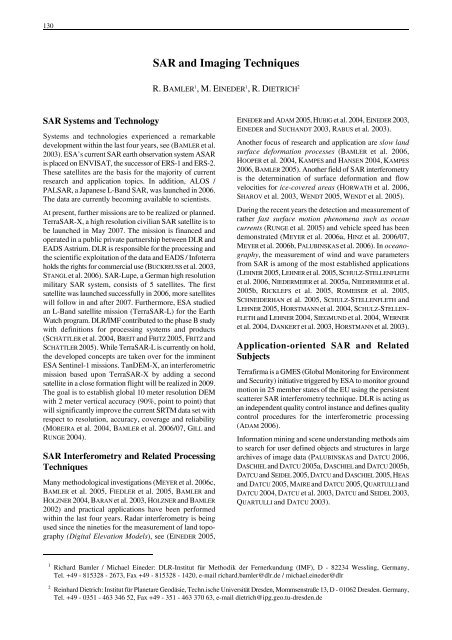NATIONAL REPORT OF THE FEDERAL REPUBLIC OF ... - IAG Office
NATIONAL REPORT OF THE FEDERAL REPUBLIC OF ... - IAG Office
NATIONAL REPORT OF THE FEDERAL REPUBLIC OF ... - IAG Office
You also want an ePaper? Increase the reach of your titles
YUMPU automatically turns print PDFs into web optimized ePapers that Google loves.
130<br />
SAR Systems and Technology<br />
Systems and technologies experienced a remarkable<br />
development within the last four years, see (BAMLER et al.<br />
2003). ESA’s current SAR earth observation system ASAR<br />
is placed on ENVISAT, the successor of ERS-1 and ERS-2.<br />
These satellites are the basis for the majority of current<br />
research and application topics. In addition, ALOS /<br />
PALSAR, a Japanese L-Band SAR, was launched in 2006.<br />
The data are currently becoming available to scientists.<br />
At present, further missions are to be realized or planned.<br />
TerraSAR-X, a high resolution civilian SAR satellite is to<br />
be launched in May 2007. The mission is financed and<br />
operated in a public private partnership between DLR and<br />
EADS Astrium. DLR is responsible for the processing and<br />
the scientific exploitation of the data and EADS / Infoterra<br />
holds the rights for commercial use (BUCKREUSS et al. 2003,<br />
STANGL et al. 2006). SAR-Lupe, a German high resolution<br />
military SAR system, consists of 5 satellites. The first<br />
satellite was launched successfully in 2006, more satellites<br />
will follow in and after 2007. Furthermore, ESA studied<br />
an L-Band satellite mission (TerraSAR-L) for the Earth<br />
Watch program. DLR/IMF contributed to the phase B study<br />
with definitions for processing systems and products<br />
(SCHÄTTLER et al. 2004, BREIT and FRITZ 2005, FRITZ and<br />
SCHÄTTLER 2005). While TerraSAR-L is currently on hold,<br />
the developed concepts are taken over for the imminent<br />
ESA Sentinel-1 missions. TanDEM-X, an interferometric<br />
mission based upon TerraSAR-X by adding a second<br />
satellite in a close formation flight will be realized in 2009.<br />
The goal is to establish global 10 meter resolution DEM<br />
with 2 meter vertical accuracy (90%, point to point) that<br />
will significantly improve the current SRTM data set with<br />
respect to resolution, accuracy, coverage and reliability<br />
(MOREIRA et al. 2004, BAMLER et al. 2006/07, GILL and<br />
RUNGE 2004).<br />
SAR Interferometry and Related Processing<br />
Techniques<br />
Many methodological investigations (MEYER et al. 2006c,<br />
BAMLER et al. 2005, FIEDLER et al. 2005, BAMLER and<br />
HOLZNER 2004, BARAN et al. 2003, HOLZNER and BAMLER<br />
2002) and practical applications have been performed<br />
within the last four years. Radar interferometry is being<br />
used since the nineties for the measurement of land topography<br />
(Digital Elevation Models), see (EINEDER 2005,<br />
SAR and Imaging Techniques<br />
R. BAMLER 1 , M. EINEDER 1 , R. DIETRICH 2<br />
EINEDER and ADAM 2005, HUBIG et al. 2004, EINEDER 2003,<br />
EINEDER and SUCHANDT 2003, RABUS et al. 2003).<br />
Another focus of research and application are slow land<br />
surface deformation processes (BAMLER et al. 2006,<br />
HOOPER et al. 2004, KAMPES and HANSEN 2004, KAMPES<br />
2006, BAMLER 2005). Another field of SAR interferometry<br />
is the determination of surface deformation and flow<br />
velocities for ice-covered areas (HORWATH et al. 2006,<br />
SHAROV et al. 2003, WENDT 2005, WENDT et al. 2005).<br />
During the recent years the detection and measurement of<br />
rather fast surface motion phenomena such as ocean<br />
currents (RUNGE et al. 2005) and vehicle speed has been<br />
demonstrated (MEYER et al. 2006a, HINZ et al. 2006/07,<br />
MEYER et al. 2006b, PALUBINSKAS et al. 2006). In oceanography,<br />
the measurement of wind and wave parameters<br />
from SAR is among of the most established applications<br />
(LEHNER 2005, LEHNER et al. 2005, SCHULZ-STELLENFLETH<br />
et al. 2006, NIEDERMEIER et al. 2005a, NIEDERMEIER et al.<br />
2005b, RICKLEFS et al. 2005, ROMEISER et al. 2005,<br />
SCHNEIDERHAN et al. 2005, SCHULZ-STELLENFLETH and<br />
LEHNER 2005, HORSTMANN et al. 2004, SCHULZ-STELLEN-<br />
FLETH and LEHNER 2004, SIEGMUND et al. 2004, WERNER<br />
et al. 2004, DANKERT et al. 2003, HORSTMANN et al. 2003).<br />
Application-oriented SAR and Related<br />
Subjects<br />
Terrafirma is a GMES (Global Monitoring for Environment<br />
and Security) initiative triggered by ESA to monitor ground<br />
motion in 25 member states of the EU using the persistent<br />
scatterer SAR interferometry technique. DLR is acting as<br />
an independent quality control instance and defines quality<br />
control procedures for the interferometric processing<br />
(ADAM 2006).<br />
Information mining and scene understanding methods aim<br />
to search for user defined objects and structures in large<br />
archives of image data (PALUBINSKAS and DATCU 2006,<br />
DASCHIEL and DATCU 2005a, DASCHIEL and DATCU 2005b,<br />
DATCU and SEIDEL 2005, DATCU and DASCHIEL 2005, HEAS<br />
and DATCU 2005, MAIRE and DATCU 2005, QUARTULLI and<br />
DATCU 2004, DATCU et al. 2003, DATCU and SEIDEL 2003,<br />
QUARTULLI and DATCU 2003).<br />
1 Richard Bamler / Michael Eineder: DLR-Institut für Methodik der Fernerkundung (IMF), D - 82234 Wessling, Germany,<br />
Tel. +49 - 815328 - 2673, Fax +49 - 815328 - 1420, e-mail richard.bamler@dlr.de / michael.eineder@dlr<br />
2 Reinhard Dietrich: Institut für Planetare Geodäsie, Techn.ische Universität Dresden, Mommsenstraße 13, D - 01062 Dresden. Germany,<br />
Tel. +49 - 0351 - 463 346 52, Fax +49 - 351 - 463 370 63, e-mail dietrich@ipg.geo.tu-dresden.de











